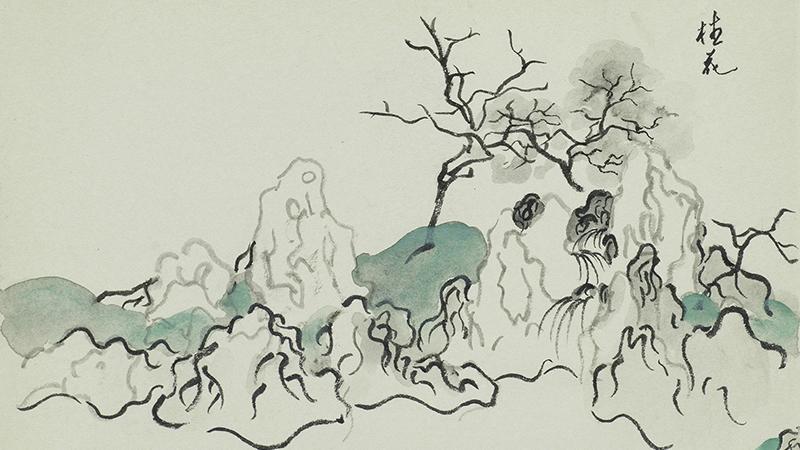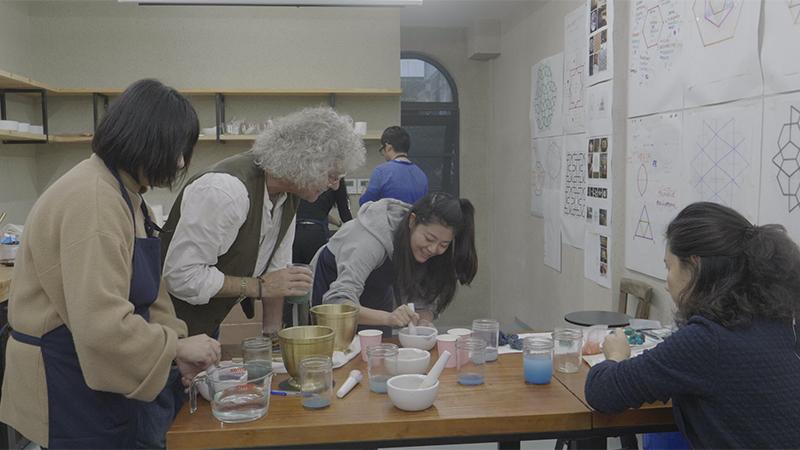The full-time one-year programme consists of individual modules that provide a sound understanding of traditional arts and crafts. The curriculum is cross disciplinary and combines drawing, design and crafts taught through presentations and demonstrations as well as studio and workshop experience. Students will learn through a holistic approach that includes visual presentations; practical application; lectures, drawing classes and tutorials as well as cultural and site visits. This unique methodology of integrating the disciplines of design and craft gives students the opportunity to appreciate and apply their artistic heritage in the contemporary context. Alongside design and crafts modules rooted within Western traditions, the course curriculum also offers traditional Chinese arts, imparting artistic principles based on the profound Chinese cosmology and unique aesthetic taste. This integration of Eastern and Western practices and philosophies makes the China Centre's Traditional Arts Foundation Course a unique learning and creative environment, where students learn how to engage with the universal principles of the language of traditional arts, and make them useful and relevant to their own contemporary practices.
Course Introduction (selected)
The Order of Nature: Geometrical Design Principles
This module encourages students to contemplate Geometry's true inherent meaning in the realm of the order of nature. Students experience geometry as a contemplative discipline. The skill of concentration, which draws forth the virtue of patience, is required throughout their whole studies. Students deepen their knowledge of design principles by studying patterns and proportions of six-, eight-, twelve- and ten-fold symmetries and their associated proportional systems. Students will also be able to analyse these patterns in the context of artistic and architectural elements. These designs are then applied into a variety of art and craft modules.
The Language of Nature: Design Motifs
Theoretical and practical learning of decorative stylisation and design motifs. Students study and compare nature to its stylisation as manifest in art. This practical study involves rigorous observation of flower and plant forms to create drawings that provide sequential steps to stylisation for a final painting. These stylisations are further arranged into composition to gain the necessary ability and skill to create new designs.
Alchemy of Colour: Methods and Materials
Students learn how to prepare colour pigments, grounds and supports according to traditional methods. They blend paint layers using various techniques to acquire practical knowledge and understanding of colour harmony and symbolism. This modules investigates the use of natural pigments—their origin, recipes, meaning and application.
Colour exploration is of extreme value to students learning crafts. Each student investigates the subtleties of colour to achieve unity, harmony and contrast, skills later transferred within the art and craft modules. Painting skills are nurtured through practice upon examples of patterns and traditional Chinese landscape painting, with a wider context of applying the principles of colour harmony in themed design projects.
The Constitution of Shanshui: Landscape and Geomancy
Part 1: In a series of thematic lectures, Prof. Ding Xiyuan analyses the formation of Chinese landscape painting (shanshui), explain the 'five elements' theory embedded in shanshui art, and introduce theories of geomancy reflected through shanshui. The lectures include an analysis of historical masterpieces, which allows a deeper insight into the history and thought of the above-mentioned narratives and theories. This is a unique and valuable learning opportunity both for practitioners and lovers of shanshui art.
Part 2: This course focuses on the compositional structure of Chinese landscape painting (shanshui) as the key thread in establishing a foundational understanding of the genre. Specifically, concentration will first be on brushwork formation, and then continue to the study of painting techniques for the two most fundamental elements of Chinese landscape art—rocks and trees—through both copying old master paintings and sketching from nature. The next topic of study is the methodology of placement in the composition, which is the core of shanshui painting, and the means by which the ancients encapsulated the formal codes of the natural world. Within a period of two weeks, students complete two study projects: a study of rocks and trees based on copying, and a landscape composition created by painting in nature.
Give Form to Myriad Things: Calligraphy
There are two main areas of instruction, as follows:
1. The history and practice of calligraphy;
2. The role of the written character and of traditional ideographic studies in the development of Chinese thought systems.
The former provides indispensable core knowledge of the culture of calligraphy, while the latter discusses the way that the ideographic word reflects China's articulation of the principles of Nature.
Part 1: The Calligraphy Studies programme will include: knowledge and understanding of Chinese characters; study of the structural form of written characters; analysis of different calligraphic styles; learning the correct writing posture; practicing the way to move the body during the act of writing. Additional topics will include understanding the tools of calligraphy, and foundational studies in the history and connoisseurship of calligraphy.
Through this step-by-step process of study and hands-on training, students will acquire a more direct and personalized understanding of the culture of Chinese calligraphy.
Part 2: using the Shuowen jiezi (An Explication of Written Characters, a dictionary complied at the end of the 1st century) as the core text, this series of lectures will analyze the spiritual thread that runs throughout the tradition of ideographic (character word) studies in Chinese culture.
Construction of Paradise: Principles of the Chinese Classical Garden
This course takes students through the compositional elements and design principles of the traditional Chinese garden, and encourages them to think about the significance of landscape painting to gardens, and contemplate the philosophical aspects of traditional garden art. In the process, students will learn to transfer designs from flat plane to three-dimensional structure; in particular, focusing on the process by which the waterways, plants and groves of a landscape painting on paper can be transformed into a physical landscape. Through the study of layering of the rocks, coordination of the waterways, selection of flowers, trees and plants, and the design and construction of pavilions, platforms, and interior design, students will learn how each of the elements form their own systems and at the same time constitute an organic whole, thus further deepening their understanding of garden design. Students will also make on-site visits to classic gardens, where they will further learn to identify garden composition and construction techniques and apply them to their design process.
Tutors at China Centre (selected)
Delfina Bottesini
Delfina Bottesini is Outreach Programme Manager and Head of Open Programme at The Prince's Foundation School of Traditional Arts in London. She is a practicing artist, designer and photographer. She has been working for the School of Traditional Arts as teacher since 2002 and as manager since the establishment of The Schools' Outreach Programme in 2005. As Outreach Programme Manager, Delfina is responsible for national and international projects, including three of The School's international Centres—in Cairo, Jeddah and Suzhou. Her artistic practice includes painting, ceramics, design and photography.
David Cranswick
Dr David Cranswick trained at the Royal Academy of Arts, London. He received a doctorate for his research into traditional painting materials and techniques in 1999 through The Prince's Foundation School of Traditional Arts. David has taught traditional painting materials and techniques since 1979. He is an MA tutor at the School and is also a PhD supervisor and examiner Cranswick is currently writing a book on traditional painting techniques and their underlying craft practices as expressed through the Alchemical tradition.
Ramiz Sabbagh
Ramiz Sabbagh is the Director of the Prince's Foundation School of Traditional Arts' Centre in Baku, Azerbaijan. Upon completing his postgraduate studies at The School in July 2001, Ramiz spent nearly ten years in Jordan. As a senior lecturer/ designer, Ramiz contributed in transforming a two-year diploma into a four-year BA Degree course and integrating it into the Jordan University system. He developed and taught the geometry curriculum that was central to all art and craft education activities of the College.
In 2011-2012, Ramiz was invited to represent The School and its ethos in China, with field study research in cultural heritage while developing and delivering workshops to local communities in Beijing and assorted Art and Design students in Shanghai. This has continued today with The School's workshops delivered annually for undergraduates in both CAFA and BIFT and to new prospective students at the new Yuan Centre in Suzhou.
Joachim Tantau
Joachim Tantau is a cabinetmaker and architectural designer living and working in Hamburg, Germany. From 2011 to 2013 Joachim studied his Master's degree at the Prince's Foundation School of Traditional Arts in London where he focussed on the history and design of fountain houses in different cultures. Since 2013 Joachim has been running a studio in Hamburg, Germany where he designs and produces high-end bespoke furniture and architectural features like garden pavilions and interiors as well as fine jewellery boxes. He works for private and corporate clients from all over the world. Recent commissions include an altar and a plinth for a rare 15th-century sculpture for St. Mary's in Abergavenny, a commission carried out under the direct patronage of HRH The Prince of Wales, and a Tabernacle for a convent in Riga, Latvia.
Lin Haizhong
Dr. Lin Haizhong, studio name Woxiasan, is a professor and doctoral advisor in the Chinese Painting department of the China Academy of Art, and deputy director of the CAA's Centre for the Authentication of Painting and Calligraphy. As an ink painter, Lin Haizhong is strongly influenced by Zen philosophy and advocates the possibility of painting as a practice of spiritual enlightenment. His works can be found in the collections of the British Museum and the National Museum of China, and in Lingyin Temple.
Jia Qin
Jia Qin is a researcher in the China Institute for Visual Studies of the China Academy of Art. Born in Yan’an in 1980, he has been writing on cross-textual topics since 2000. He is the author of Wuzhuanshu (Panchatantra) (2007); Xiandaipai wenxue cidian (Dictionary of Modernist Literature) (2010); Hubian: cidian de junbei (The Tiger Changing its Stripes: Preparing the Dictionary); and is the chief editor of Muduo wenku (Muduo Library Series) (New World Publishers). He was also the first scholar to create a systematic introduction to Oulipo littérature potentielle within a Chinese language context. Jia Qin has also been a participant in special events such as One Hundred Years of Dada in China (2016), Shanshui Manifesta (2016), and Yunqi 2050 Conference (2018).
Lu Dadong
Lu Dadong, born in 1973 in Yantai, Shandong province, Prof. Lu received his PhD in Calligraphy from the China Academy of Art. In 1991 he was admitted to the Department of Chinese Painting at the Zhejiang Academy of Fine Arts where he studied under Wang Dongling, specializing in calligraphy and seal carving. He is currently a researcher in the Research Centre for Chinese Calligraphy at the China Academy of Art. Since 1995 he has also been a keen practitioner of rock music, and is the lead singer in the Hangzhou-based indie rock band Yuren yuedi.
Ye Fang
Ye Fang is an artist, garden designer and educator. Professor Ye was born into a scholarly family. He is devoted to promoting the art of the garden within a contemporary context. Across his work in different media—whether ink painting, sculpture, installation or landscape design—his understanding of the Chinese garden as it is informed by culture and tradition has always been a connecting thread.
The garden Ye Fang designed and constructed in Suzhou, Nan Shi Pi Ji, is the only contemporary Chinese garden listed in UNESCO's report on Suzhou's classic gardens, after nine of the most famous historical gardens; and his work Da Yuan (Da Garden) which was shown at the 53rd Venice Biennale, was the first artwork related to classical Chinese garden design to be featured there.


